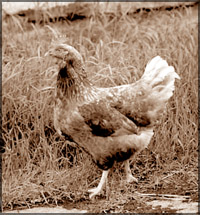'Designer' chickens that could save lives
 Scientists
have created a breed of designer chickens with eggs that can produce
life-saving drugs.The breakthrough could help the fight against diseases
such as cancer and dramatically cut the cost of treatments. Scientists
have created a breed of designer chickens with eggs that can produce
life-saving drugs.The breakthrough could help the fight against diseases
such as cancer and dramatically cut the cost of treatments.
But it will worry opponents of the genetic modification techniques
the scientists used. The 500-strong flock was bred at Edinburgh's Roslin
Institute, the birthplace of Dolly, the cloned sheep.
The chickens' DNA was altered (changed) so that their eggs contained
complex medicinal proteins.
The proteins can be extracted (taken out) to make drugs for humans.It
is the first time scientists have successfully manipulated (managed) the
birds' DNA so that their characteristics are passed down the
generations. Previously, the ability to make the valuable proteins had
vanished in a generation or two.
The scientists had also announced the successful production of
anti-cancer proteins in the whites of eggs.

Since then, they have made dramatic strides which could lead to the
creation of egg drug factories.
Such a development would slash (cut) production costs.
At present, disease-beating proteins are mainly created in vats of
bacteria or other cells that have been genetically modified.
This makes extracting the relevant proteins expensive and difficult.
The Roslin scientists used some of the GM chickens to create interferon.
A drug based on this human protein is widely used to treat multiple
sclerosis.
The chickens have also been used to create an antibody that could
tackle skin cancer. The avian transgenic manufacturing project is a
joint venture between the Roslin Institute and the biotechnology firms
Viragen and Oxford BioMedica.Karen Jervis, of Viragen Scotland, held out
the prospect of many more treatments.
"We have bred several generations of chickens so far, and they all
keep producing high concentrations of pharmaceuticals", said Dr Jervis.
"This is potentially a very powerful new way to produce specialised
drugs. We chose two candidates, but we have got others coming through.
"What we want is to produce as many possibilities as we can to show
that we can apply the technology to many drugs. Theoretically, there is
no restriction on the type of drugs that can be produced."
It is likely to be several years before the breakthrough could have a
commercial application.
Any resultant drugs would have to go through the rigorous (severe)trial
procedures faced by any new drug. This can take six years. Some
scientists are cautious (careful) about the development and say similar
advances have been trumpeted for nearly two decades.
The world's most successful transgenic animal so far has been a pet
called the 'glofish'. This tropical fish was genetically modified with
the DNA of a sea anemone and a jelly fish to give it fluorescent skin.
But Dr Barbara Glenn of Bio. which represents the American biotech
industry said that the Roslin research would pave the way for more
breakthroughs.
"This technique is simply a way of producing human proteins, which is
why it is applicable to so many diseases", she said.
Daily Mail
|
